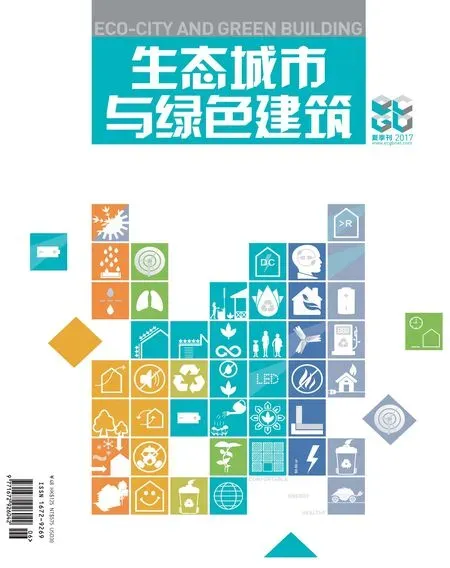居住区底层架空设计对风环境影响研究
席天宇 丁建华 雷永生 / XI Tianyu, DING Jianhua, LEI Yongsheng
居住区底层架空设计对风环境影响研究
席天宇 丁建华 雷永生 / XI Tianyu, DING Jianhua, LEI Yongsheng
底层架空设计不但能有效改善室外风环境,还可创建避免太阳直射的室外活动空间,在热带和亚热带地区被广泛采用,系统研究架空设计的风环境影响对基于环境优化的居住区设计具有一定参考价值。本研究以广州市为例,采用结合非稳态放射计算的CFD耦合模拟方法,对不同架空率下居住组团的风速平均值和累积度数展开对比研究。研究结果显示,在非架空区域,随着底层架空率的增加,低风速累积分布比例逐渐缩减,当底层架空率超过60%时,平均风速增长率出现拐点,增速加快;在架空区,随着架空率的提升风环境有明显改善,当架空率达到80%时,平均风速增长率出现拐点,增速放缓。值得注意的是,架空率较低时,其改善架空区风环境的能力有限,当架空率为40%时,架空区风速均低于0.3m/s。
居住区 风环境 底层架空 CFD耦合模拟
1 引言
联合国政府间气候变化专门委员会(Intergovernmental Panel on Climate Change,IPCC)第三次评估报告指出,20世纪全球平均温度上升了0.6±0.2℃。城市环境恶化不仅增加了能源消耗,还引发了人类健康问题,已在世界范围内引起了广泛关注。亚洲城市多属湿热气候,城市热岛现象尤为严重,针对该问题,亚洲各国在国家层面和地方层面采取了多种措施,以改善室外热环境,如提高环境绿化率、建筑围护结构采用高反射性能材料、改善城市通风、利用海风、减少人工散热等。
在室外热环境研究方面,国内外学者通过现场实测、模拟和风洞实验等方法做了大量研究(Yoshida Shinji et al.,2002;Tetsu Kubota,Supian Ahmad,2006;Uehara Kiyoshi,Ymamao Yukio,2007;Takanobu Moriizumi et al.,2008;Yoshida Shinji et al.,2003;Harayama Kazuya et al.,2002),但鲜有底层架空设计对室外环境影响的系统研究。热带和亚热带气候区广泛采用底层架空的设计方法,以改善风环境并提供避免太阳直射的室外活动空间(图1,Tianyu Xi et al.,2016),因此,底层架空设计对室外环境的影响应成为政府部门、设计师和使用者共同关注的问题。
席天宇等发表关于广州市多种建筑环境的实测结果,其中包含底层架空方面的研究,但没有采用模拟软件进行系统分析(Tianyu Xi et al.,2011a;Tianyu Xi et al.,2011b;Tianyu Xi et al.,2012;Tianyu Xi et al.,2011c);金虹等采用三维非稳态放射计算方法模拟了底层架空对平均辐射温度的影响,但未涉及风环境相关内容(Tianyu Xi et al.,2014;Tianyu Xi et al.,2015);李琼等采用耦合模拟法研究半开敞空间(100%架空率)对居住区室外热环境的影响,但未与不同底层架空率的情况进行对比研究(Tianyu Xi et al.,2009)。
行列式是居住组团布局的主要形式之一,在居住形态布局中处于主导地位(陆严冰,2016)。本文以广州市为例,结合非稳态放射计算的CFD(Computational Fluid Dynamics,计算流体力学)耦合模拟,旨在探讨不同架空率对行列式多层居住区风环境的综合影响,为深入了解行列式居住区不同架空率的区域风环境提供准确的数据分析,并对基于环境优化的居住区设计和风环境改善提供参考。
2 模拟方法与实验设计
2.1 模拟方法
传统模拟方法视同一物性表面温度为均一值,忽略了物体表面辐射换热、墙体和地面热传导等因素的影响,不能反映环境的真实情况,且物体表面温度的简化计算使浮力项的计算受到影响,导致CFD流体计算精度降低。
为了提高风环境模拟精度,本研究采用了非稳态放射计算与一维导热计算相结合的耦合模拟计算方法。首先假设同一物性表面温度为单一恒定值,调用当地气象数据(包括风速、风向、温度和湿度等),进行流体模拟。而后采用非稳态放射计算方法(包括三维辐射和一维导热计算),对地表和建筑表面温度进行模拟,取得精确值。基于上述两步的计算结果,再次进行CFD耦合模拟分析,获得更准确的平均风速分布数据和风向数据。

图1 亚热带气候区建筑的底层架空设计
2.2 模拟案例设计
同样架空率情况下,架空区域分布位置存在多种组合(图2),架空率均为50%。为缩小研究范围,本研究在建筑正中间设置架空区,对架空率为0(无架空)、40%、60%、80%和100%(完全架空)5种情况展开模拟研究。

图2 架空区布局位置
2.3 边界条件设定
模拟区域建筑高度设定为21m,进深设定为15m,模拟工况5个。依据日本建筑协会(Architectural Institute of Japan,AIJ)标准,对模拟域设定如下:流体流入边界与建筑物边界之间的距离设为建筑高度的5倍 ;流体流出边界与建筑物边界之间的距离设为建筑高度的15倍。此外,为避免边界效应影响,采用在居住区中心部位评价单元的数据作为CFD模拟结果的评价依据(图3,Tianyu Xi et al.,2016)。

图3 模拟区域的大小、风向和建筑朝向(平面、三维示意)
依据每小时的平均气象数据计算日平均数据(每日24h),累计得到全夏季数据并计算平均值,而后计算逐日平均数据与全夏季平均数据的标准差,选择日平均数据最接近全夏季平均值的一天(7月14日)作为分析日期。模拟的开始时间设为15:00,即广州市最高温度出现的时间。
模拟步骤包括(Tianyu Xi et al.,2017):第一步,设定流体模拟计算边界条件(表1);第二步,设定非稳态放射计算边界条件(表2~6);第三步,设定耦合模拟计算边界条件(表7)。
3 模拟结果分析
当架空率分别为0、40%和60%时,非架空区风速在数值上被明显划分为低速区和高速区两个部分,风速较高的区域位于居住区的风道上,风速较低的区域主要集中于建筑的前后两侧;当架空率为80%时,高速区和低速区界限消失,低风速的累积度数(Cumulative Degree)显著降低,小于0.9m/s的累积度数约为20%;当架空率达到100%时,非架空区的最低风速值达到0.9m/s,风速明显提高(图4 ~ 8,Tianyu Xi et al.,2017)。
当底层架空率低于60%时,非架空区平均风速的增速较缓;当架空率达到60%时,平均风速增长率出现拐点,增速变快(图9,Tianyu Xi et al.,2017)。
随着架空率的增加,非架空区风速平均值从1.2m/s(无架空)增加到1.8m/s(全部架空),风环境得到了显著改善。
3.1 非架空区风环境

表1 流体模拟边界条件设定

表2 非稳态放射计算边界条件设定

表3 地表和建筑表面参数设定

表4 墙体结构热工参数设定

表5 屋顶结构热工参数设定

表6 地面结构热工参数设定

表7 耦合模拟计算边界条件设定

图4 非底层架空区风环境(架空率:0)
3.2 架空区风环境
当底层架空率为40%时,架空区风速均小于0.3m/s,大于0.3m/s的风速累积度数为0。当架空率为60%时,小于0.3m/s的风速累积度数降至20%左右,大于0.5m/s的风速累积度数达到80%,大于1.3m/s的风速比例为40%,架空区风环境改善明显。当架空率为80%时,架空区风速均大于0.7m/s,且0.7~1.3m/s的风速累积度数仅为20%,大于1.3m/s的风速比例为80%。当架空率达到100%时,架空区风速均大于1.1m/s,弱风区完全消失(图10~13,Tianyu Xi et al.,2017)。
提高架空率对改善架空区风环境效果显著,架空率每增加20%,架空区平均风速约提高0.5~0.6m/s。当架空率为40%时,架空区平均风速约为0.2m/s,表明低架空率对架空区风环境的改善效果极其有限;当架空率达到80%时,增长率出现拐点,平均风速的增速放缓,降至0.1~0.2m/s左右,表示架空率为80%~100%的时候,对风环境的改善效果有限(图14,Tianyu Xi et al.,2017)。

图5 非底层架空区风环境(架空率:40%)

图6 非底层架空区风环境(架空率:60%)

图7 非底层架空区风环境(架空率:80%)

图8 非底层架空区风环境(架空率:100%)

图9 非底层架空区平均风速

图10 架空区风环境(架空率:40%)

图11 架空区风环境(架空率:60%)

图12 架空区风环境(架空率:80%)

图13 架空区风环境(架空率:100%)

图14 架空区平均风速
4 结论
当架空率低于80%时,居住区非架空区的显著特征为建筑的前后两侧形成低风速区,风道上形成高风速区。当架空率达到80%时,低风速区累积度数显著降低,有80%比例风速超过0.9m/s。非架空区的平均风速随架空率的增长而增加,当架空率达到60%时,平均风速增长率出现拐点,增速加快。
居住区架空区的风环境随着架空率增加而明显改善,当架空率为60%时,有40%比例的风速超过1.3m/s;当架空率为80%时,超过1.3m/s的风速比例达到80%。
值得注意的是,较低的架空率难以营造良好的风环境,如架空率为40%时,平均风速只有0.2m/s左右,最高风速不超过0.3m/s。架空区的平均风速随着架空率的增长而增加,当架空率达到80%时,平均风速增长率出现拐点,增速放缓。
本文研究对象为亚热带行列式多层居住区,架空部分均设置在住宅中心位置,因此研究结果存在一定局限性。
[1]Yoshida Shinji, Murakami Shuzo, Narita Ken-ichi, et al. Field Measurement of Outdoor Thermal Environment within Courtyard Canyon Space around Apartment Complex in Summer[J]. Paper Collection of Plan System of Annual Meeting of Architectural Institute of Japan, 2002.
[2]Tetsu Kubota, Supian Ahmad. Wind Environment Evaluation of Neighbourhood Areas in Major Towns of Malaysia[J]. Journal of Asian Architecture and Building Engineering, 2006(1).
[3]Uehara Kiyoshi, Ymamao Yukio, Oikawa Susumu, Mochida Akashi.Wind-tunnel Experiments on Improving the Natural Ventilation of a Street-Canyon[J]. Journal of Japan Society for Atmospheric Environment, 2007(5).
[4]Takanobu Moriizumi, Toru Kawai, Atsushi Inagaki, Manabu Kanda. Outdoor Urban Scale Model Experiments on the Effects of Building Height Variation on the Atmosphere[J]. Journal of Hydroscience and Hydraulic Engineering, 2008.
[5]Yoshida Shinji, Murakami Shuzo, Mochida Akashi, et al. In fl uence of Green Area Ratio on Outdoor Thermal Environment with Coupled Simulation of Convection, Radiation and Moisture Transport[J]. Paper Collection of Planning System of Annual Meeting of Architectural Institute of Japan, 2003.
[6]Harayama Kazuya, Yoshida Shinji, Ooka Ryozo, et al. Numerical Study Based on Unsteady Radiation and Conduction Analysis:Prediction of Outdoor Environment with Unsteady Coupled Simulation of Convection, Radiation and Conduction Part 1[J].Paper Collection of Planning System of Annual Meeting of Architectural Institute of Japan, 2002.
[7]Tianyu Xi, Qiong Li, Akashi Mochida. Research on Outdoor Climate and Thermal Comfort in Subtropical Climate Urban Areas:A Study in Guangzhou, China, as an Example. Summaries of Technical Papers of Annual Meeting of Architectural Institute of Japan[J], Environmental Engineering, 2011a.
[8]Tianyu Xi, Qiong Li, Akashi Mochida, Qinglin Meng. The Outdoor Thermal Environment and Thermal Comfort of Piloti in Subtropical Climate Cities[J]. Journal of Habitat Engineering, 2011b(2).
[9]Tianyu Xi, Qiong Li, Akashi Mochida, Qinglin Meng. Study on the Outdoor Thermal Environment and Thermal Comfort around Campus Clusters in Subtropical Urban Areas[J]. Building and Environment, 2012.
[10]Tianyu Xi, Qiong Li, Akashi Mochida, Qinglin Meng. A Study on the Influence of Various Human-built Elements on Outdoor Thermal Comfort in Subtropical Climate Cities. 4th International Conference on Human-Environment System, ICHES 2011 in Sapporo, Japan, 2011c.
[11]Tianyu Xi, Jianhua Ding, Hongjin. Study on the In fl uence of Piloti on Mean Radiant Temperature in Residential Blocks by 3-D Unsteady State Heat Balance Radiation Calculation[J]. Journal of Harbin Institute of Technology, 2014(4).
[12]Tianyu Xi, Hong Jin, Jianhua Ding. Study on the Comprehensive Influence of Piloti Ratio on Mean Radiant Temperature in Residential Communities in Subtropical Climate Cities in China.2015 International Conference on Materials Engineering and Environment Science, MEES2015 in Wuhan, China, 2015.
[13]Tianyu Xi, Yingli Xuan, Akashi Mochida. Research on the Effects of Semi-open Space on the Outdoor Thermal Environment of Residential Communities in the Subtropical Zones: Simulation of Residential Communities in Guangzhou, China, as an Example.Technical papers of Annual Meeting of Society of Heating, Air conditioning and Sanitary Engineers of Japan, 2009.
[14]Tianyu Xi, Hong Jin, Akashi Mochida, Jianhua Ding. Research on the Residential Block's Outdoor Thermal Comfort by Questionnaire Survey and Coupled Simulation Method in Guangzhou, China. 3rd International Conference on Advances in Energy, Environment and Chemical Engineering, 2017.
[15]Tianyu Xi, Jian-Hua Ding, Hong Jin. Study on Comprehensive Influence on Wind Environment of Piloti in Residential Blocks in Guangzhou, China. International Forum on Energy, Environment and Sustainable Development (IFEESD 2016).
[16]陆严冰. 行列式街坊与围合式街坊——以日照标准为线索的城市居住形态演进[C]//. 中国城市规划学会, 沈阳市人民政府.规划60年:成就与挑战——2016中国城市规划年会论文集. 北京: 中国建筑工业出版社, 2016.
EFFECT ON WIND ENVIRONMENT OF PILOTI DESIGN IN RESIDENTIAL COMMUNITY
First floor piloti design can not only optimize the outdoor wind environment, but also create activity spaces which avoid the direct radiation from the sun, which is commonly used in building design in tropical and subtropical climate zones. Taking the city of Guangzhou as an example, by adopting a coupled CFD simulation method, this research firstly designed a series of cases, and then compared the mean wind velocity and cumulative values of the simulation results. The results showed that, for those areas out of piloti, cumulative values of low wind velocity decreased with the increase of piloti ratio,and the inflection point appears at 60 percent piloti ratio for the mean wind velocity (increase trend to be faster after inflection point). For the areas under piloti, the wind environment was highly optimized by the increase of piloti ratio, and the inflection point appears at 80 percent piloti ratio for the mean wind velocity (increase trend to be slower after inflection point). It was noticed that, the very low piloti ratio contributes little to the wind environment under piloti areas, for example, all wind velocity under piloti areas are lower than 0.3m/s when piloti ratio is 40 percent.
Dwelling District, Wind Environment, Piloti Design, Coupled CFD Simulation
由中国国家自然科学基金项目提供资助(编号:51408160、U1504528),部分研究资助来自中国博士后科学基金(编号:2015M571419),教育部留学归国基金;哈尔滨市青年后备人才项目(编号:2015RQQXJ068);黑龙江省博士后科学基金(编号:LBH-Z15084)和黑龙江省寒地建筑科学重点实验室青年基金(编号:2016HDJZ-1206)。
席天宇,哈尔滨工业大学建筑学院
丁建华,通讯作者,深圳大学本原设计研究中心,深圳大学建筑与城市规划学院
雷永生,哈尔滨工业大学建筑学院
2017-07-27

